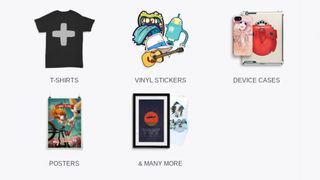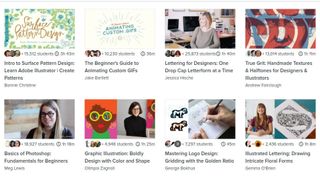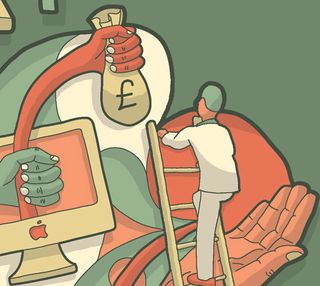Got your post-Christmas credit card statement yet? Worried you’re going to spend all year sacrificing the good things in life in order to pay it off? Well, it doesn’t have to be this way.
There are multiple ways you can earn extra income from your design skills. All it takes is a bit of extra effort and perseverance, and you could soon be running a financial surplus.
In this post, we look at some creative ways you could boost your income in the year to come.
01. Turn your designs into physical products

One common way to make money from your talents is to turn your designs into physical products, such as prints, T-shirts, mugs, tote bags, phone cases, and then sell them online.
There are plenty of places to sell your design products online, including Society 6, Etsy, Design by Humans, Redbubble and Threadless.
Each has a different way of doing things so it’s worth checking out which one will suit your needs best. For example, some arrange production and shipping of the products themselves, so you just have to supply the design work and everything else is taken care of.
Alternatively, you could cut out the middleman and add a shop to your own website, which would give you greater creative control and mean you can keep a greater share of the profits. If you don’t have web design skills, there are many platforms that will help you build in this kind of ecommerce functionality the easy way, including Shopify, Big Cartel and Squarespace. Most will offer free trials to get you started at zero cost.
For more info on making money from your product designs, check out our articles How to sell your work online and The art of licensing: how to sell your designs to market.
02. Sell digital assets

Don’t want to make physical products? Then why not tap into the lucrative market for original digital assets, including vector graphics, icon sets, fonts, photos, 3D models, website themes, templates, Photoshop filters, and so on?
You may not even need to create new work: consider whether you have any unused assets from rejected or discontinued projects you could easily recycle.
There are numerous places to tout your digital assets to the design community, including Creative Market, Graphics River and ThemeForest. If you’re looking to see vectors, illustrations, icons or photography, also check out stock libraries, which can provide a potentially massive audience for your work.
It’s a jungle out there, of course, and the insane levels of competition mean you may be best off trying lots of different things until you hit the right niche. To get started, check out 5 secrets to creating digital products people will buy, How to make money selling stock illustrations, How to make serious cash selling website templates and How to make money from your 3D models.
03. Write about your design specialism

Even if the idea of doing design work outside of 9-5 fills you with dread, there are still ways to exploit your skills to make some extra cash. One is to write about design.
This might mean, for example, penning articles for an industry blog or magazine. Of course, this field is very oversubscribed so you’ll need a specific angle or intriguing niche to get anyone interested. (And before you ask, we’ve got all the help we need ourselves!) This post includes nine popular design sites that do pay for articles, and there are many more.
Alternatively, you could publish your own ebook and deal directly with your audience. To get started, read this post on our sister site TechRadar about How to Self-Publish on Kindle.
Sniffy about the idea of an ebook? Although it requires a little investment, it’s perfectly possible to print your own books instead (and you can potentially charge much more as a result). Start with this advice from leading designers Tony Brook and Adrian Shaughnessy on how to publish your own book on a shoestring.
Also check out our posts on How to design a book in InDesign and How to design the perfect book cover.
04. Teach design skills

Remember all the struggles you had learning to be a designer? If only you’d known then what you know now. Well, perhaps you could do the same for young designers who are struggling today, and earn some handy cash in the process.
Again, there are different levels to approach this. You could start small, writing tutorials on your chosen subject for industry titles. For example, The Graphic Design School Blog, Photoshop Tutorials, Photoshop Contests, Envato Tuts, and SitePoint all pay good money for contributions (submission details in the links).
Another way of sharing the benefit of your design experience could be to try your hand at speaking at design events.
Unless you’re already well known in the community, you’ll probably have to do a few free gigs at small events first and build your way up, but the bigger events do pay pretty well, not to mention offer the opportunity to travel. Check out conference directory Lanyrd to find your niche, and click through to the relevant event websites for details of speaker submissions. Also check out our designer’s guide to public speaking.
Then, if you really want to go the whole hog, you could always set up your own online course, either through a platform such as Skillshare, Udemy or CreativeLive, or set up your own website and sell direct.
As ever, it pays to do your research first to establish that there is both demand for your topic and no current competitors in the same space. Here’s a list of 10 platforms you can use to host your online course.
05. Earn affiliate income from your website

It’s one of the oldest and simplest ways to earn income on the internet: place affiliate links to products you write about in your blog, which then earn you small amounts of money if people click through and buy.
You’re never going to become mega-rich this way, but if you’re already writing about something like a book from Amazon or a service like Creative Market, say, it’s a no-brainer to add in a quick affiliate link, as Irish graphic designer David Airey does on his excellent blog. It costs nothing but a few seconds of time and it could end up providing some useful beer money.
06. Raise your freelance rates

Whenever you speak to experienced freelancers, you hear the same story. They’d worked for far too many years without upping their rates. Then they finally took the plunge, and were delighted to find it didn’t deter clients at all. In fact, sometimes it made them keener; by charging more, people may even think of your services as being more valuable!
Obviously, every freelancer’s personal circumstances are different, and we wouldn’t encourage you to do anything that might risk your financial stability. But if you’ve been charging the same rates for years, a small rise may be worth experimenting with in 2018.
Certainly, if you find you’re taking on too much work, or turning projects down because you’re too busy, you should be seriously considering it.
For more on this, read How to calculate your freelance rate, 4 ways to cash in as a freelancer, and 7 different pricing models – and which you should choose.
07. Negotiate a salary rise

Working in a salaried position where you’ve grown your skills and experience over time, taken on extra responsibilities, and generally feel you’re providing better value to your employer than ever before?
Then in 2018, why not ask them to put their money where their mouth is, and reward you with a better salary?
We’re not going to lie, though: whether you get it or not may well depend on external factors well beyond your (or even your boss’s) control. So before you rush headlong into making demands, it pays to do your research, assess the state of the business as a whole and your department in particular, put some feelers out, and get a sense of whether it’s worth pursuing.
For tips and advice, read our 7 tips for getting paid more and 5 killer ways to nail that salary negotiation.
08. Ask for a promotion

If your boss won’t give you more money for what you do currently, the best way to increase your earnings may be to pursue a new, better-paid position.
There are plenty of strategies for getting a promotion, but in essence it’s about deciding clearly where you want to be and working out how to get there. It’s also about communication: setting out your goals clearly to your manager so you can work towards them together, because they may otherwise have very different views on how they see you progressing.
Follow our 15 tips on how to get a promotion, 20 tips for design interview success and How to craft a standout portfolio.
Liked this? Read these next:

Thank you for reading 5 articles this month* Join now for unlimited access
Enjoy your first month for just £1 / $1 / €1
*Read 5 free articles per month without a subscription

Join now for unlimited access
Try first month for just £1 / $1 / €1
Get the Creative Bloq Newsletter
Daily design news, reviews, how-tos and more, as picked by the editors.

Tom May is an award-winning journalist and editor specialising in design, photography and technology. Author of the Amazon #1 bestseller Great TED Talks: Creativity, published by Pavilion Books, Tom was previously editor of Professional Photography magazine, associate editor at Creative Bloq, and deputy editor at net magazine. Today, he is a regular contributor to Creative Bloq and its sister sites Digital Camera World, T3.com and Tech Radar. He also writes for Creative Boom and works on content marketing projects.